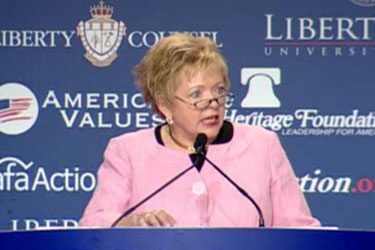As Access to Safe Abortion Care Diminishes in Arizona, Rural Women Face Growing Hurdles
Now that only doctors can perform abortions, rural women in the state have very limited options.

If you are a woman who has just discovered you are pregnant, want an abortion, and you live in Flagstaff, Arizona, you get to drive two and a half hours one way to a clinic in Phoenix. Live in Holbrook? That’s 3 hours and 30 minutes.
This isn’t an issue to Cathi Herrod, President of the anti-choice group Center for Arizona Policy, who among other things, pressured lawmakers to pass a bill that made it impossible to provide abortions in any of the clinics outside the state’s two biggest cities, Phoenix and Tuscon. The Arizona law requiring that abortions only be performed in person by a physician curtailed even early medication abortions in areas like Flagstaff. Herrod claims that is not any sort of burden to the women outside the metro areas. According to Ahwatukee Foothill News:
Herrod said she does not believe the restrictions have created significant problems for women living outside the state’s two major metropolitan areas.
“Women living in rural areas certainly have access to medical services in Phoenix or Tucson,’’ she said. “So that’s not the issue.’’
Women in Ahwatukee Foothills, a suburb of Phoenix, don’t have much reason to be concerned about the lack of access to clinics. Nor are the residents likely to face onerous inconveniences because of a statewide 24-hour waiting period requiring two trips to a clinic before an abortion can be performed. For a Flagstaff woman on the other hand, that is an increase in the costs of both time and money.
Is it any wonder then that advocates within the state are looking at options for women to obtain an abortion in other states, even when the procedure is still technically legal in Arizona? USA Today interviewed Carrie Klaege of Abortion Access Network of Arizona, who is looking for clinics to send women to in order to get an abortion after 18-weeks post fertilization if the Arizona version of the so-called “fetal pain” ban ever makes it through the courts.
From the USA Today article:
In the year since Carrie Klaege moved to Arizona and started a non-profit program to help poor women afford abortions, she’s watched access to the procedure get tougher for her clients.
Following a rash of new laws, abortions are no longer available at clinics outside Tucson and Phoenix and women must wait 24 hours after required ultrasound tests before terminating pregnancies — forcing some to travel hundreds of miles and stay overnight. Klaege said she’s now making connections in other states where she could send women if the courts allow a ban on later abortions to take effect.
“Abortion is legal, but when you have to travel 300 miles to get to a clinic that provides the services you need, you don’t really have access,” says Klaege, co-founder of the Abortion Access Network of Arizona and the former clinic director for Dr. George Tiller, a Kansas physician murdered in 2009 for performing abortions. “The availability and access to services is being severely impacted, and it is starting to cause some real difficulty for women.”
So far, Klaege only appears to be focused on alternate arrangements for those that would be affected by the new ban. But for women in rural areas of the state, a first trimester abortion is becoming almost as difficult to access. The procedure may not be banned outright, but when a woman in Holbrook has the choice of driving nearly 200 miles to access an abortion in Phoenix, or drive an additional 30 minutes more to get one in Albuquerque, New Mexico. Add in a mandatory waiting period requiring at least one overnight stay in Arizona, and abortion might as well be banned in her home state.
We’ve seen abortion turn into a fight against time, finances and TRAP laws in states like Mississippi, South Dakota, Oklahoma, and other states with one lone clinic. But what we have also lost sight of is the fact that so many other states are in nearly as much of a crisis because access is only “easily” available to those who live in large metro areas and close to populated city centers. In the end, it doesn’t matter how many clinics a state has when they remain out of reach of rural women.
